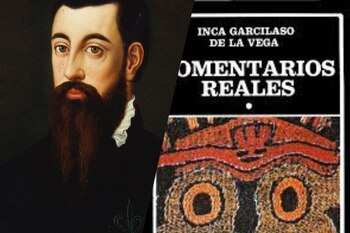
A week after commemorating his birth (April 12), it is a good excuse to remember the Inca Garcilaso de la Vega and his iconic works, which are still valid in Peruvian and international history. The Spanish-Peruvian writer and historian stands out for being the “first biological and spiritual mestizo in America”. His stories have left their mark, and perhaps the best known is the so-called 'Real Commentaries of the Incas', a literary historical book that had its first publication in 1609, in Lisbon, Portugal.
What is it about? More than 400 years after its publication, it is still part of the archives in national literature and history. The work portrays the history, customs and traditions of Ancient Peru, according to what Garcilaso de la Vega was able to collect. Divided into nine books, with details and facts through documents, chronicles and oral information that the writer obtained during that period. The facts contain the stories he sent to Francisco Huallpa and to the gentleman Garcí Sánchez de Figueroa, along with letters and visits from friends arriving from America.
Other sources are the chronicles of authors such as Cieza, Father Acosta, Blas Valera. His memory also allowed him to give him resources to create the work, based on his childhood experience. To the point that it had a reissue in Madrid in 1723, in 1800-1801 (it is published under the title General History of Peru or Royal Commentaries of the Incas, in 13 volumes) and in 1829 (in five volumes, the first and second parts). What is the structure of the book? It is the following with nine books of 262 chapters:
- Dedication.
- Reward to the reader.
- Warnings.
- Book One (26 chapters).
- Book Two (28 chapters).
- Book Three (25 chapters).
- Fourth Book (24 chapters).
- Book Fifth (29 chapters).
- Sixth Book (36 chapters).
- Seventh Book (29 chapters).
- Eighth Book (25 chapters).
- Book Ninth (40 chapters).
WHY IS IT CALLED “REAL COMMENTS OF THE INCAS”?
Garcilaso de la Vega chose this title because he considered his testimony to be the most truthful. He sought to make a difference with the other Spanish chroniclers, because he considered that they did not have that attribute that made the difference. How did he manage to show originality? He highlighted the fact that he was a descendant of the former Peruvian rulers, who knew his native language.
Remember that in the Royal Commentaries, the Inca Garcilaso de la Vega intends to achieve two objectives: to fulfill the duty of telling the history of the Incas and that of his father and companions, and the other is to establish his identity as a mestizo. Memory helps him achieve both purposes and also make sense of the title as he tells the stories of the Incas and legends of yesterday.

GARCILASO AND THE TRIUMVIRATE
As is known, Garcilaso de la Vega is part of the triumvirate of writers together with William Shakespeare and Miguel de Cervantes de Saavedra. Recognized as essential authors along with their works worldwide more than 400 years after their deaths. For this reason, every April 23, World Book and Copyright Day is celebrated, a recognition that began in 1995.
It is known that Cervantes died on April 22, but at that time, in the 16th century, custom dictated that the date of death should be recorded on the day of burial, which was the 23rd. In fact, in the historical record of the book of the deceased of the church of San Sebastián in Madrid it appears this way.
For his part, the author of Romeo and Juliet, among other classics, did die on April 23, although the date is not exact in today's world, since then the Julian calendar still survived in much of Europe. With the transition to the Gregorian calendar, which is used today in most countries on the planet, the true date of his death would be May 3.
The case of the Peruvian Garcilaso de la Vega is not without controversy either. Different historians date his death on three different days: April 22, 23 or 24, 1616. Thus, at the 28th session of UNESCO, held in Paris, the request of the International Union of Publishers, which aimed to promote culture and the protection of intellectual property through copyright, was accepted.

KEEP READING
Últimas Noticias
Debanhi Escobar: they secured the motel where she was found lifeless in a cistern
Members of the Specialized Prosecutor's Office in Nuevo León secured the Nueva Castilla Motel as part of the investigations into the case

The oldest person in the world died at the age of 119
Kane Tanaka lived in Japan. She was born six months earlier than George Orwell, the same year that the Wright brothers first flew, and Marie Curie became the first woman to win a Nobel Prize

Macabre find in CDMX: they left a body bagged and tied in a taxi
The body was left in the back seats of the car. It was covered with black bags and tied with industrial tape
The eagles of America will face Manchester City in a duel of legends. Here are the details
The top Mexican football champion will play a match with Pep Guardiola's squad in the Lone Star Cup

Why is it good to bring dogs out to know the world when they are puppies
A so-called protection against the spread of diseases threatens the integral development of dogs




